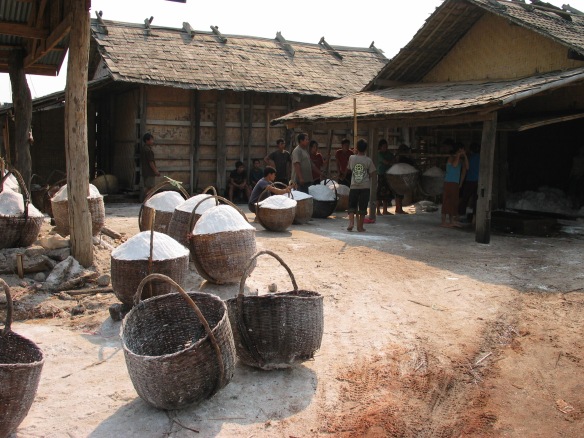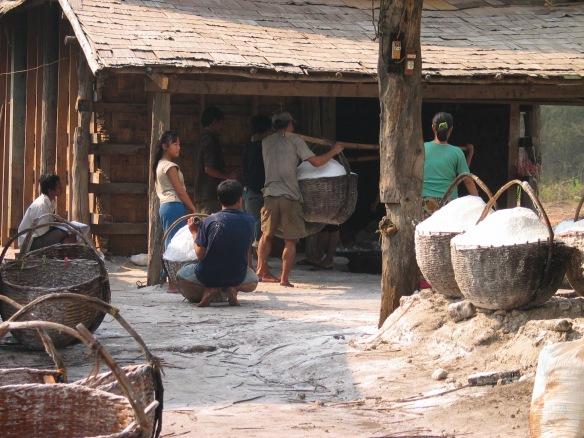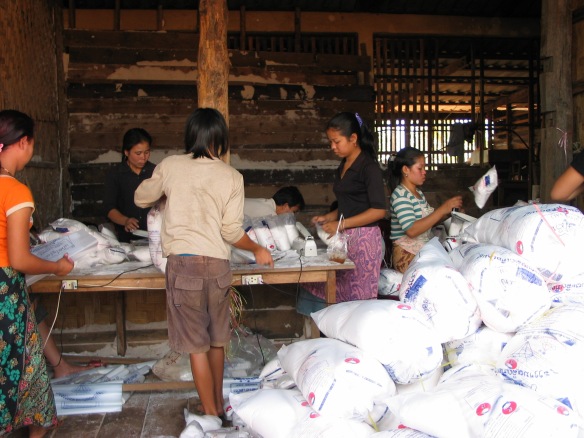When we talk about salt, we talk most often of sodium chloride. This is NaCl, consisting of the elements sodium and chlorine.
There is a charming tradition in Germany of bringing a loaf of bread and salt to friends when they move into a new home. The saying is that if you have those two items in your house you’ll always survive. Bread and salt are still ceremoniously served to guests in parts of northern and eastern Europe.
Mark Kurlansky writes, “Loyalty and friendship are sealed with salt because its essence does not change. In both Islam and Judaism, salt seals a bargain because it is immutable… In Christianity, salt is associated not only with longevity and permanence but, by extension, wth truth and wisdom. The Catholic Church dispenses not only holy water but holy salt, Sal Sapientia, the salt of wisdom.” [1]
Seeing the hard way salt is won from pits changed forever the way I think about this simple condiment.
We were staying for only a few days in Vientiane, the capitol of Laos, and spent a day with a guide and a driver to see a bit of the area. One of the spots we toured was a traditional salt harvesting town. A little settlement lives at and from the pits (and has burned down numerous times). Each time, they rebuild right next to the pits.
 Salty waters are brought up from deep underground
Salty waters are brought up from deep underground
 and then boiled in open metal pans. Their burning fires glowed and sent off intense heat. The briny steam that rose felt like being in some strange circle of Dante’s Purgatory.
and then boiled in open metal pans. Their burning fires glowed and sent off intense heat. The briny steam that rose felt like being in some strange circle of Dante’s Purgatory.
 Once the water has boiled away the salt is gathered in baskets, weighed, and stored in a barn.
Once the water has boiled away the salt is gathered in baskets, weighed, and stored in a barn. 
Workers then bag and tag the salt, preparing it for market.
Salt is a serious business. The salt from this mine is sent to the north where people still suffer endemic goiters.
I thought of the pits of hell, of work so demanding and hot that it left scars. Just being tied to a spot like this must bake you and make you hard. Or so I thought. Instead, I met workers doing their jobs in neatly ironed clothing. The women all had on jewelry. A group of little children trailed us everywhere, laughing and mugging as children do.
Since that day salt has tasted both sweeter and bitterer, or herber as the Germans say. And in that small word I hear the echo of the coming season, Herbst, Autumn. The summer is burning away and fall is coming. May your harvest tables everywhere include bread and salt.
NOTES: [1] Mark Kurlansky, Salt: A World History (Vintage Books, 2002), p. 7.
(All photographs can be enlarged by simply clicking on the image.)
Uwe’s photos of our trips to Laos and his photography may be viewed at viewpics.de. Go to my earlier posts Despair Is An Exotic Ingredient or A Visit to the Food Bank, Part 1 & 2 for more about food.







We went to the same place – a very hard life. Also had cheerful kids following us and mugging for the camera. I too think differently about salt after that visit.
Alison
Alison, it is incredible to me to hear from someone who was also here… “knowing” this place changed how we view things as simple as a condiment and as complex as life. Thank you for commenting!
To wish someone bread and salt is a blessing indeed–
This is a wonderful read, Jadi, thank you.
Always glad to see a comment from you, Chris!
Thank you for sharing the photos and stories. Such a hard work, it’s so sad to see the condition of the workplace…
Indeed. As I say, I’ll never look at salt the same way agan.
You remind me of the Little House in the Big Woods books, and how Pa would wait at a salt lick for deer to come.
Such a beautiful post. I was amazed by both the story and the photos, never thought of harvesting salt that way. Of course I never gave much thought to it all, except in regards to how some of our American pioneers obtained it. Truly enjoyed reading this.
Elizabeth, thanks for such a thoughtful comment! I never considered salt in any way other than how much was too much to put in the soup, etc… Doing research for this post led me to the wonderful quotes on salt as sacred. What can you tell me about how the early pioneers got salt?
They’d gather it from dried salt springs or lakes, collect salt water and let the water evaporate in the sun. Or boil it, which is about the same as the method in your article. And then there were salt mines. I guess where there’s a will, there’s a way.
Fascinating look into an age-old product that just keeps popping up throughout history. Love your pictures, too.
Like I wrote: I look at salt differently now. Uwe’s photos show the process in images that words can’t!
What a lovely post! Salt and bread for your table, too!
Those and a little cheese (and a bottle of wine) ((and a lit candle)) make me quite happy.
I am hugely interested in the history, culture and lore of herbs and spices so this is right up my alley. Thank you for this wonderful insight into another form of salt production of which I was not aware.
–peace, bread and salt to you!
You will want to look at Mark Kurlansky’s book named “Cod” too. He is a wonderful writer. PS: I love the idea of “peace, bread and salt to you”.
I usually say, “Peace, Love and Crabcakes”!
Herbst, Autumn. The summer is burning away and fall is coming. May your harvest tables everywhere include bread and salt.
Jadi, that sentence is so beautiful and so aptly describes the season. Lovely essay and wonderful photos. Thank you Judy Patton
Judy, what a lovely comment – thank you! I love autumn, and Thanksgiving has always been my favorite American holiday. Bread and salt indeed….
May your table always contain bread and salt too Jadi.
xxx Huge Hugs xxx
That is so kind of you, and just the sort of comment I’d expect you to make.. Thanks David; and may your table always contain them as well.
Hi Jadi. I love this story. You are up late! Hope you are doing well. Hope to see you soon. Love Liz
Sent from my iPad
>
I wrote this post and scheduled it for release, so I was sleeping the sleep of the innocent when it appeared…Drop me an email with your plans!